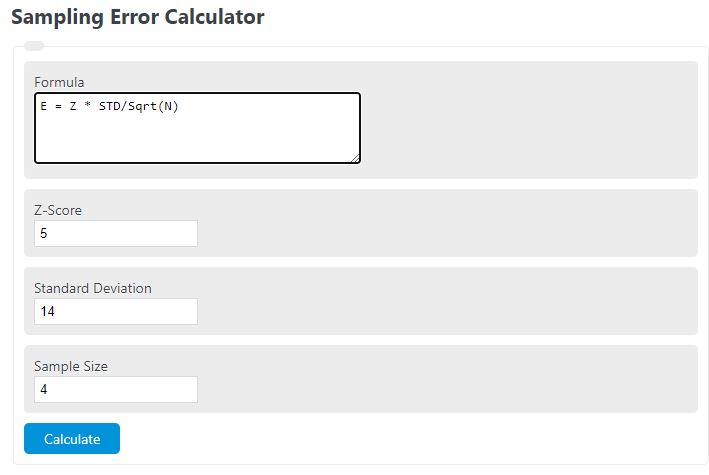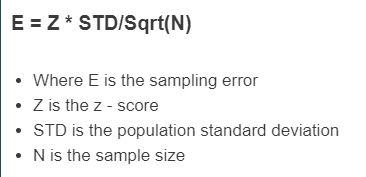Enter the z score, population standard deviation, and sample size to determine the sampling error.
- T Statistic Calculator (T-Value)
- Z-Score Calculator
- Confidence Interval Calculator (1 or 2 means)
- Inter-Rater Reliability Calculator
- Sturges’ Rule Calculator
Sampling Error Formula
The following formula is used to calculate a sampling error.
E = Z * STD/Sqrt(N)
- Where E is the sampling error
- Z is the z – score
- STD is the population standard deviation
- N is the sample size
To calculate the sampling error, multiply the z-score by the population standard deviation, then divide by the square root of the sample size.
Sampling Error Definition
A sampling error is defined as the inherent error in the selection of a sample of data from a greater population of data.
Sampling Error Example
How to calculate sampling error?
- First, determine the Z-score.
Using the confidence level, determine the z-score.
- Next, determine the population standard deviation.
Calculate the standard deviation of the entire population.
- Next, determine the sample size.
Measure the sample size used for the analysis.
- Finally, calculate the sampling error.
Calculate the sampling error.
FAQ
What factors can influence the magnitude of the sampling error?
Several factors can influence the magnitude of the sampling error, including the size of the sample (larger samples tend to have smaller sampling errors), the variability in the population (more variability can lead to larger sampling errors), and the sampling method used (random sampling methods are designed to minimize sampling error).
How can sampling error be reduced?
Sampling error can be reduced by increasing the sample size, ensuring the sample is representative of the population through proper sampling methods, and reducing variability within the data set by stratification or other techniques.
Is sampling error the same as measurement error?
No, sampling error and measurement error are not the same. Sampling error occurs due to the selection of a sample from a population, whereas measurement error arises from inaccuracies in data collection, recording, or analysis. Both can impact the accuracy of statistical results but originate from different sources.

